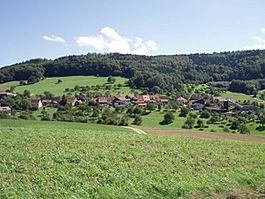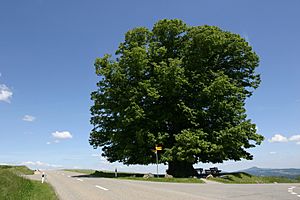Linn, Aargau facts for kids
Quick facts for kids
Linn
|
||
|---|---|---|

Linn village
|
||
|
||
| Country | Switzerland | |
| Canton | Aargau | |
| District | Brugg | |
| Area | ||
| • Total | 2.55 km2 (0.98 sq mi) | |
| Elevation | 570 m (1,870 ft) | |
| Population
(Dec 2011)
|
||
| • Total | 136 | |
| • Density | 53.33/km2 (138.1/sq mi) | |
| Postal code |
5225
|
|
| Surrounded by | Effingen, Gallenkirch, Schinznach-Dorf, Unterbözberg, Villnachern, Zeihen | |
Linn used to be a small town, also known as a municipality, in the Brugg district of Aargau canton in Switzerland. On January 1, 2013, Linn joined with three other towns – Gallenkirch, Oberbözberg, and Unterbözberg – to create a new, bigger municipality called Bözberg.
Contents
History of Linn
Linn was first mentioned in old writings around the years 1303 to 1308. At that time, it was called ze Linne or ze Lind. Its name probably comes from a very old and famous Linden tree. This special tree is between 500 and 800 years old and stands to the east of Linn.
During the Middle Ages, Linn was likely part of the Elfingen area. This area was managed by local rulers. In 1460, Linn became part of the Bözberg court, which was in the Canton of Bern.
At first, people from Linn belonged to the Elfingen-Bözen church area. After 1649, they joined the Bözberg church area. Before the Reformation in 1528, Linn had its own small church, called a chapel. The Reformation was a big change in how people practiced Christianity.
Farming was the main way people made a living in Linn until the mid-1800s. Many farming families moved away during that time because it became harder to find work. By the end of the 1900s, there were only seven farms left. Most other people living in Linn worked in the nearby town of Brugg. Since the 1990s, you can reach Linn by Postauto, which is like a public bus service.
Linn's Geography
In 2009, Linn covered an area of about 2.55 square kilometers (about 1 square mile). A large part of this land, about 50.6%, was used for farming. Forests covered another big portion, about 44.3% of the area. The remaining land, about 4.7%, was built up with buildings and roads.
Most of the built-up area was for homes and other buildings (3.1%). Roads and other transport areas made up 1.6%. About 42.4% of Linn's land was covered by thick forests. Another 2.0% had orchards or small groups of trees. For the farming land, 23.1% was used for growing crops. Pastures for animals covered 25.5%, and 2.0% was used for fruit trees or grapevines.
Linn is located in the Brugg district. It sits on a flat area of the Bözberg mountain, southwest of the mountain pass. The town itself is a linear village, meaning its buildings are spread out along a main road.
Linn's Coat of Arms
A coat of arms is a special design that represents a town or family. Linn's coat of arms shows a green Linden tree on a silver background. The tree stands on a green hill.
The name Linn comes from the legendary 500- to 800-year-old Linden tree that is east of the town. Because the coat of arms clearly shows this tree, it is an example of a "canting arm." This means the design on the coat of arms hints at the name of the place.
People of Linn (Demographics)
In 2013, Linn had a population of 136 people. As of June 2009, about 8.8% of the people living in Linn were from other countries. Over ten years, from 1997 to 2007, the number of people living in Linn grew by about 29.1%.
Most people in Linn speak German (96.4%). French is the second most common language (2.7%), and Dutch is third (0.9%). This information is from the year 2000.
In 2008, the age groups in Linn were:
- 14 children (10.1%) were between 0 and 9 years old.
- 17 teenagers (12.3%) were between 10 and 19 years old.
- 10 adults (7.2%) were between 20 and 29 years old.
- 15 adults (10.9%) were between 30 and 39 years old.
- 37 adults (26.8%) were between 40 and 49 years old.
- 23 adults (16.7%) were between 50 and 59 years old.
- 13 older adults (9.4%) were between 60 and 69 years old.
- 5 older adults (3.6%) were between 70 and 79 years old.
- 4 older adults (2.9%) were between 80 and 89 years old.
In 2000, the average home in Linn had about 0.56 people per room. This was similar to the average for the whole canton. A "room" here means a living space of at least 4 square meters (about 43 square feet). This includes bedrooms, dining rooms, living rooms, kitchens, and usable basements or attics. About 72.5% of homes were owned by the people living in them.
Also in 2000, there were 2 homes with 1 or 2 people, 16 homes with 3 or 4 people, and 22 homes with 5 or more people. The average number of people in each home was 2.73. In 2008, 26 homes (46.4% of all homes) were single-family houses. In 2007, no new homes were built in Linn.
In the 2007 Swiss federal election, the most popular political party was the SVP. They received 54.3% of the votes. The next most popular parties were the FDP (12.7%), the SP (7.6%), and the CVP (6.6%).
About 88.3% of people in Linn aged 25 to 64 have finished high school or gone on to higher education, like university. In the 2008/2009 school year, 13 students from Linn attended primary school in the municipality.
The table below shows how Linn's population has changed over time:
| Historical population | ||
|---|---|---|
| Year | Pop. | ±% |
| 1764 | 137 | — |
| 1850 | 171 | +24.8% |
| 1900 | 130 | −24.0% |
| 1950 | 113 | −13.1% |
| 2000 | 112 | −0.9% |
Linn's Economy
In 2007, Linn had a low unemployment rate of 1.62%. In 2005, 23 people worked in the primary economic sector, which includes farming and forestry. There were 11 businesses in this sector.
Four people worked in the secondary sector, which involves manufacturing and construction. There were 2 businesses in this sector. Thirteen people worked in the tertiary sector, which includes services like shops and offices. There were 5 businesses in this sector.
In 2000, 68 people who lived in Linn had jobs. About 67.6% of these residents worked outside of Linn. Only 6 people traveled into Linn for work. There were 28 jobs in Linn that required at least 6 hours of work per week. Of the people who worked, 8.5% used public transportation to get to their jobs, and 53.5% used a private car.
Religion in Linn
According to the 2000 census, 24 people (21.4%) in Linn were Roman Catholic. Most people, 78 (69.6%), belonged to the Swiss Reformed Church.
Sights to See in Linn
The village of Linn is recognized as an important part of Inventory of Swiss Heritage Sites. This means it has special cultural and historical value.
See also
 In Spanish: Linn (Argovia) para niños
In Spanish: Linn (Argovia) para niños





